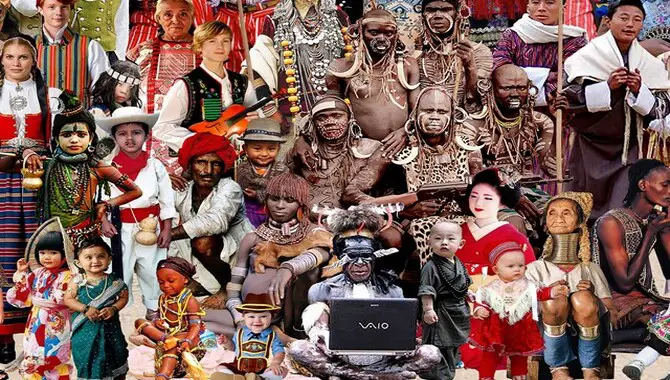In today’s society, cultural appropriation is a growing problem. Using elements of another culture without the people of that culture’s consent or appreciation can be incredibly hurtful and disrespectful.
There are many ways people can appropriate aspects of other cultures, whether a hairstyle, food, music, art, etc. Some of them don’t always have well intentions. While cultural appropriation isn’t always harmful, it is often seen as such and has been pushed as an important conversation in our society.
In today’s society, there’s a constant push for cultural unity, so when people from different cultures come together to celebrate their differences without understanding each other’s culture and values, things can get messy fast.
There are examples of cultural appropriation everywhere: people “wearing Asian stereotypes,” blackface performances, or people taking elements of another culture without giving proper credit or appreciation to the culture from copying.
We must discuss this topic because it’s becoming increasingly common for people not to be aware of the implications of what they’re doing or saying. Read on to learn more about cultural appropriation and how to avoid it in your day-to-day lives!

Definition Of Cultural Appropriation

Cultural appropriation is taking from a culture without the permission of the culture’s owner. Cultural appropriation is an attempt to assimilate elements of another culture without regard for cultural boundaries, norms, or values. Regarding fashion, it is important to be aware of the implications of cultural appropriation before engaging in it. This includes evaluating the social and cultural significance of elements sought from another culture.
And they understand why and how a dominant culture has adopted cultural elements. Recognizing when and why cultural elements are no longer acceptable by their original culture. It is also important to be sensitive to how different cultures value their traditions and cultural heritage. It’s vital to consider the differences in each group’s history and current state of development when engaging in cultural appropriation.
Elements Of Cultural Appropriation

It is important to understand the difference between cultural appropriation and cultural appreciation. Cultural appropriation occurs when one culture borrows elements of another culture without consent or acknowledges that culture in a way that is not equitable.
For example, it could include wearing traditional clothing without permission, using cultural symbols without authorization, or using elements of another culture without respecting its traditions, culture, or history.
When engaging in cultural appropriation, it’s important to be aware of the implications of your actions for both the individual and the culture as a whole. Cultural sensitivity refers to the understanding of other cultures and cultures in general. Sensitivity involves being respectful of other cultures and history while being inclusive.
Appropriation can take many forms, from wearing traditional clothing without permission to using cultural symbols without authorization. The best way to avoid cultural appropriation is to know the consequences of one’s actions for both the individual involved and for other members of the culture.
Culture

Cultural appropriation is taking elements of a culture without respecting it and its traditions. It can involve wearing traditional clothing or using cultural symbols without appropriate context. It can harm the original culture and people, often leading to stereotypes and misrepresentation.
When engaging with other cultures, it’s important to be aware of our intentions and the social and cultural context of the interaction. Doing so can prevent cultural appropriation and foster respectful and meaningful interactions with other cultures.
Appropriation

Cultural appropriation is taking something from a culture without permission or understanding the implications. Several elements make up cultural appropriation, including using cultural symbols without permission, stereotypes, and cultural expressions without the appropriate context.
It’s important to be aware of cultural appropriation’s consequences and avoid it whenever possible. We can learn about our shared history by respecting different cultures and traditions and inspire future generations. By acknowledging the impact of cultural appropriation, we can ensure that people from all backgrounds have a voice in society.
Cultural Denigration
Cultural appropriation is the act of taking from a culture that is not your own without permission. It can harm the culture from which the item was taken and denigrate the cultural traditions themselves. There are several ways to avoid cultural appropriation. One way is by being aware of what you are wearing and using.
Another way is by asking before using cultural items or rituals. Always try to learn about the history and traditions of the culture from which the item came. This will help you understand and appreciate different cultures and traditions instead of only taking from them.
Cultural Appreciation & Respect
Cultural appropriation is the act of taking something from one culture and using it without permission or respect. It can occur in various situations, from wearing traditional clothing to using cultural symbols without understanding their meaning. Cultural appropriation often results in misunderstandings between the original culture and the culture adopting elements of its traditions without understanding their significance.
By showing appreciation for the cultures being used, people can avoid damaging relationships between them. Instead, they can show respect for the people and culture of origin while learning about another culture. By showing appreciation for the cultures being used, people can avoid misunderstandings or damage to the relationship between the two cultures. This respectful approach will help both groups live together harmoniously.
Tips To Avoid Cultural Appropriation

Everyone needs to be aware of the culture and context of the items used to avoid cultural appropriation. Also, it’s vital to respect cultural differences and ask permission from the group or individual you intend to Appropriate. It’s important to research the history and significance of the cultural item you intend to use before using it.
Finally, when photographing or filming individuals or groups who may be sensitive about their cultural heritage being displayed publicly, be careful not to stereotype or misrepresent them. By taking these steps, everyone can avoid appropriation and show appreciation and respect for other cultures.
1.Be Aware Of The Cultural Context Of The Item Or Activity You Are Taking Part In

When engaging in cultural appropriation Following things can be harmful. Like copying or using elements of a culture without giving credit to the people who originated that culture. This can be harmful to the community and disrespectful to the people who have contributed to that culture.
It’s important to be aware of the cultural context of the item or activity you are taking part. You ensure it to avoid cultural appropriation. And respect the cultural heritage of the people involved in that culture. These include asking permission before using any cultural materials or traditions.
Learning about the history and context of the culture you are trying to imitate. And avoiding making assumptions about what is appropriate behavior when it comes to cultural traditions. By being respectful and mindful of a culture’s history, people show appreciation. Specifically for all of the people contributing to a culture’s rich cultural heritage.
2.Ask Permission Before Using Cultural Symbols Or Icons.
There is a growing concern over using cultural symbols and icons without permission. Some people believe that it can lead to cultural appropriation. When elements of a culture or identity people use without their cultural significance or permission. Therefore, people need to be aware of cultural symbols and icons before using them.
Additionally, if people choose to use images or videos that contain cultural symbols, they must ask permission from the source. Permission should always be obtained when using cultural symbols or icons. Because they represent a culture and may have significant meaning. If you doubt using a symbol or icon, it is best to consult a knowledgeable authority.
3.Respect The Traditions, Customs, And Values Of The Culture You Are Interacting With

It is important to respect a culture’s traditions, customs, and values when interacting with them. When interacting with cultures, respecting their traditions, customs, and values is important. It is essential to understand the symbols and images associated with the culture.
Consult an expert if you need help with how to conduct yourself when interacting with a culture properly. Additionally, be aware of the symbols and images associated with that culture. By respecting a culture’s traditions, customs, and values, you can better understand the people and culture you are interacting with.
4.Utilize An Interpreter If Needed
Cultural appropriation occurs when a person adopts aspects of another culture without understanding or respect for that culture. For example, it can involve wearing traditional clothing, using traditional recipes, or taking on cultural stereotypes. If you are still determining whether or not you are engaging in cultural appropriation, reach out to an interpreter who can help you understand the cultural context of your actions.
Additionally, understanding and respecting other cultures is essential for a healthy global society. By engaging in respectful behaviors, such as learning about another culture and accepting its traditions and values, we can all contribute to a more culturally diverse world.
5.Be Aware Of The Cultural Context And History Of The Items You’re Wearing Or Using.

Cultural appropriation is the act of taking part in or using cultural practices or symbols without consent from the original owner. It can harm the culture and community from which the items originate. There are a variety of ways to avoid cultural appropriation, including being aware of the cultural context and history of the items you’re wearing or using.
This can help you interact with people from different cultures with respect and sensitivity. Additionally, remember that everyone has a unique perspective on culture, and we should all be willing to learn from one another. By paying attention to other people’s cultural heritage and traditions, we can all learn about our shared history and culture without appropriation.
6.Make A Genuine Effort To Learn About The Culture You’re Interacting With
Cultural appropriation is taking elements of a culture and using them without permission. When engaging in cultural appropriation, you take elements of a culture and use them without understanding or respect. You can avoid cultural appropriation by genuinely learning about the culture you’re interacting with.
If unsure whether something is culturally appropriate, err on caution and avoid it. Instead, seek to understand and appreciate the culture you are taking elements from. Many resources are available to help you learn about different cultures, so take advantage of them!
7.Examples Of Cultural Appropriation
Awareness of the difference between cultural appreciation and cultural appropriation is imperative. Cultural appropriation refers to taking something from a culture without giving it back in return, which can damage the community from which they took the thing. This term has gained prominence in recent years as people increasingly engage with cultures other than their own. The term ‘cultural appropriation’ hasn’t been widely used, but it’s important to pay attention to that difference.
For example, wearing traditional clothing without proper knowledge or respect, using cultural symbols without authorization, and making derogatory comments about culture are examples of cultural appropriation. This can result in stereotypes of that culture being perpetuated, which can have negative consequences for the group involved.
If you encounter any issues while traveling or interacting with different cultures, it is important to speak up and seek help from those more knowledgeable about the subject.
Rock ‘N’ Roll
Cultural appropriation occurs when one culture uses elements of another culture without permission or approval. Rock ’n’ roll, a genre of music that originated in the United States, has been adopted by many cultures worldwide. Some argue that rock ’n’ roll is an example of cultural appropriation because it borrows heavily from African and Caribbean music styles.
It is important to be aware of the various cultural appropriation types and avoid them when possible. In some cases, cultural appropriation can lead to stereotypes or misrepresentations of a culture. By paying attention to different cultures and their unique traditions, we can better understand them and respect their histories and contributions to our society.
Sweat Lodge
Cultural appropriation is using or representing a culture or tradition without the permission of the culture or its members. Sometimes cultural appropriation can be unintentional, as in the case of non-native people adopting the cultural practices of their host countries. However, cultural appropriation is often done intentionally, as in the case of non-native people adopting their host country’s cultural practices without understanding or respecting that culture’s traditions and values.
When visiting a sweat lodge, it is important to respect the culture and its traditions. It is also important to be aware of examples of cultural appropriation, such as wearing traditional clothing, using cultural symbols, and performing rituals incorrectly. This can ensure that visitors are respectful of other cultures and traditions and that they do not disrespect or harm them in any way.
Voguing
Cultural appropriation is the act of taking elements of a culture without crediting or respecting that culture. It is the act of taking from a culture without giving credit or respect to that culture. Voguing, a subgenre of ballroom dance, was developed in New Orleans during the 1940s and 1950s and has elements of various African-American cultural traditions.
Some people believe that voguing is an example of cultural appropriation because it takes elements from different African-American cultures and combines them into one dance style. Others argue that voguing should not be condemned as cultural appropriation, as it is a cultural expression reflecting the diversity of the black community. Rather, people can avoid cultural appropriation when participating in events or activities associated with a particular culture.
Team Mascots
Cultural appropriation is the act of taking something from one culture and using it without permission or respect. Some common examples of cultural appropriation include wearing traditional clothing without permission, using a name from a culture without permission, or using symbols from a culture without permission.
It’s important to be aware of cultural appropriation’s consequences before engaging in it. By learning about the culture from which an item comes and respecting its traditions, you can avoid cultural appropriation and instead honor the culture from which the item originated.
When engaging in cultural appropriation, being respectful and taking responsibility for your actions is vital. If you are unsure about whether an activity is culturally appropriating, ask yourself if it would be OK to do the same thing to another culture
In summary, a cultural appropriation is an act of taking something from one culture and using it without permission or respect. There are many examples of cultural appropriation, including wearing traditional clothing without permission, using a name from a culture without permission, or using symbols from a culture without permission. By avoiding cultural appropriation, you can honor the culture that gave birth to the item in question and celebrate its rich heritage and diverse traditions.
How To Know If Something Is Cultural Appropriation

Before you embark on any cultural appropriation, it’s vital to be aware of the cultural context from which that activity or item is taken. This means looking for signs that the item or activity isn’t appropriate for a particular culture.
For example, if someone is wearing a costume of blackface, that person is likely mocking black people and should be aware of the cultural context in which such an act takes place. Similarly, when using symbols or ideas from another culture without due credit or appreciation, you disrespect that culture’s traditions and heritage.
Finally, before taking anything from another culture, it’s important to ask permission from the people from that culture. This shows respect and appreciation for their culture and helps prevent any potential harm to the community. Overall, cultural appropriation can be vital in building bridges between different cultures and societies. However, it would be best if you did it with a thorough understanding of the cultural context and without harming others.
One of the most important things we can do to prevent cultural appropriation in the future is to be aware of its dangers. Cultural appropriation is when a person from one culture takes elements of another for amusement or commercial gain without asking permission. This can be damaging not only to the people who are being appropriated but also to the culture itself.
Always respect the culture, heritage, and traditions of the people you interact with. Do not take elements of a culture for your amusement or commercial gain. If you are unsure whether something is appropriate, ask permission from the person or group you are interacting with.
Conclusion
It’s crucial to be aware of the cultural context of the items you’re taking part in and to make an effort to learn about that culture to avoid cultural appropriation. The more you know about a culture, the less likely you will make mistakes. The next time you want to take part in something cultural, try reading up on the culture beforehand.
This will help you understand its meaning and be prepared for any questions that arise. Next time when someone asks you if they can ‘do’ something cultural without permission, show them examples of cultural appropriation and how they could avoid it.
Frequently Asked Questions
1.What Is The Difference Between Cultural Appropriation And Appreciation?
Ans: The main difference between cultural appropriation and appreciation is that appropriation typically involves taking things from another culture without permission. In contrast, appreciation acknowledges the cultural context of an item or activity and aims to preserve it.
2.Is It OK To Take Something From Another Culture, Or Is That Wrong?
Ans: Cultural appropriation can be seen as OK or even helpful in some cases, depending on the situation. For example, suppose a person from another culture is wearing the traditional clothing of their own culture, and you want to wear the same outfit. In that case, that may be considered cultural appropriation.
3.Why Do People Get Offended By Cultural Appropriation?
Ans: When people experience cultural appropriation, it can be a way of feeling excluded and unintelligent. It can also give others the false impression that they know more about another culture than they do.
4.What Should I Do If Someone Tells Me I’m Appropriating Their Culture?
Ans: If you’re unsure whether something you’re doing is cultural appropriation, it might be best to ask your accuser directly. If they don’t want the thing taken away, then consider respecting their wishes and stopping the activity altogether.
5.Is There Any Way To Know If Someone Is Doing This Without Being Racist?
Ans: There is no single way to know for sure if someone is cultural appropriation without being racist. However, one way to try and avoid this is to be aware of the cultural context of the culture you are trying to imitate. This means that you should study the culture before attempting to emulate it in any way.

I’m a writer and blogger who loves to talk about entertainment, culture, and relationships. I love to share my thoughts and insights on these topics, and I’m always looking for new ways to engage with my readers. I’m also a big fan of learning new things, so I’m always exploring new areas of interest.
